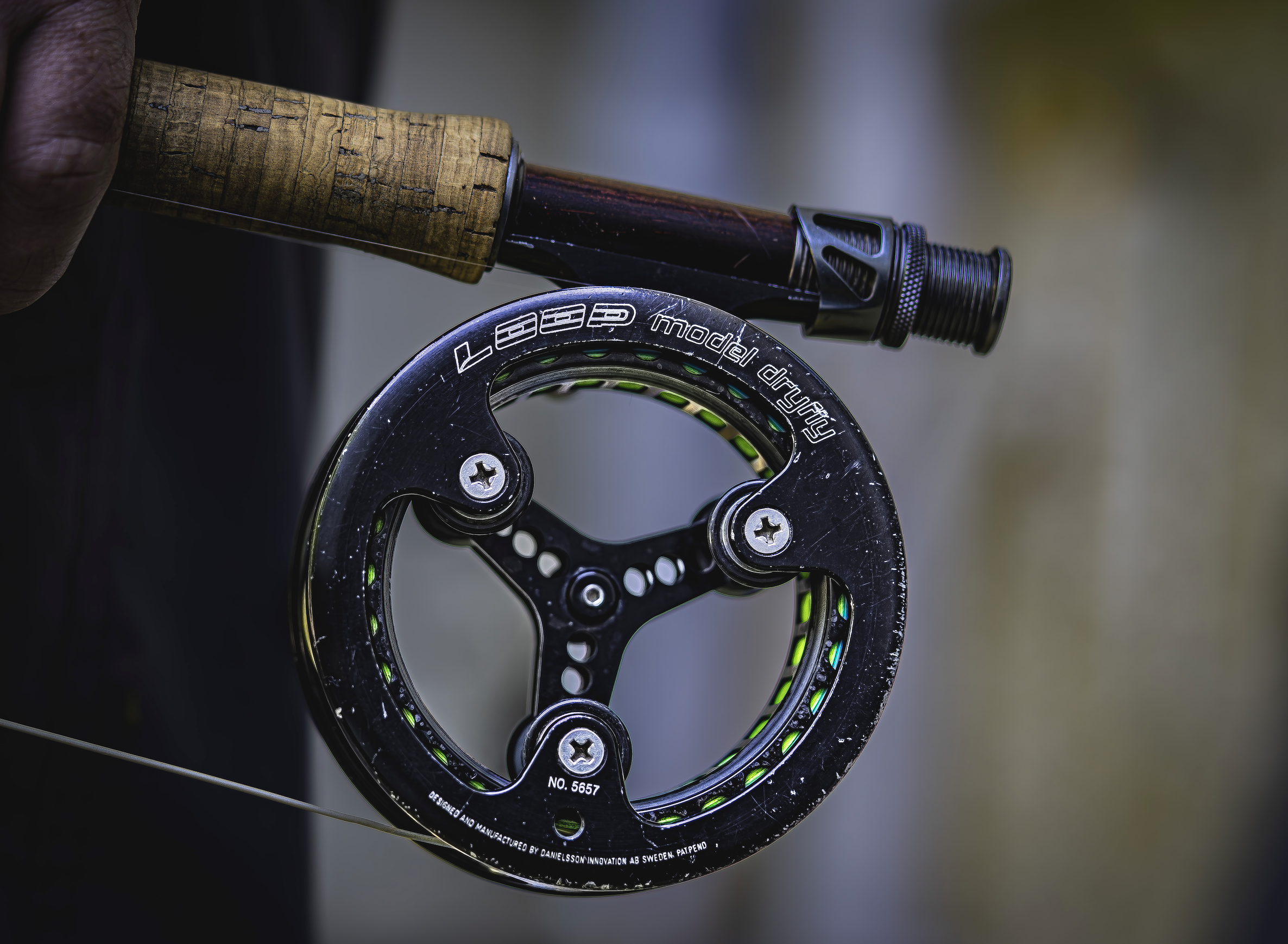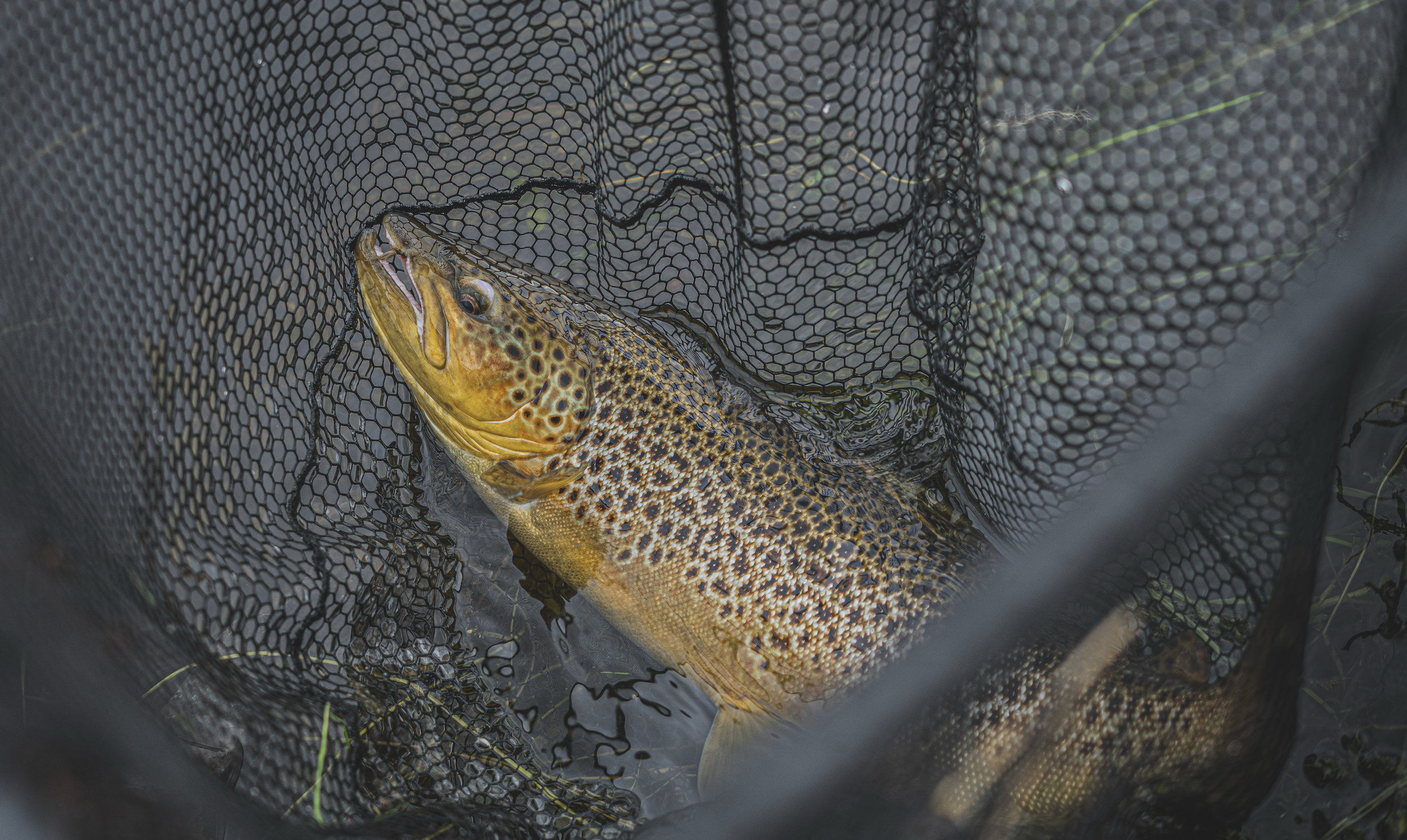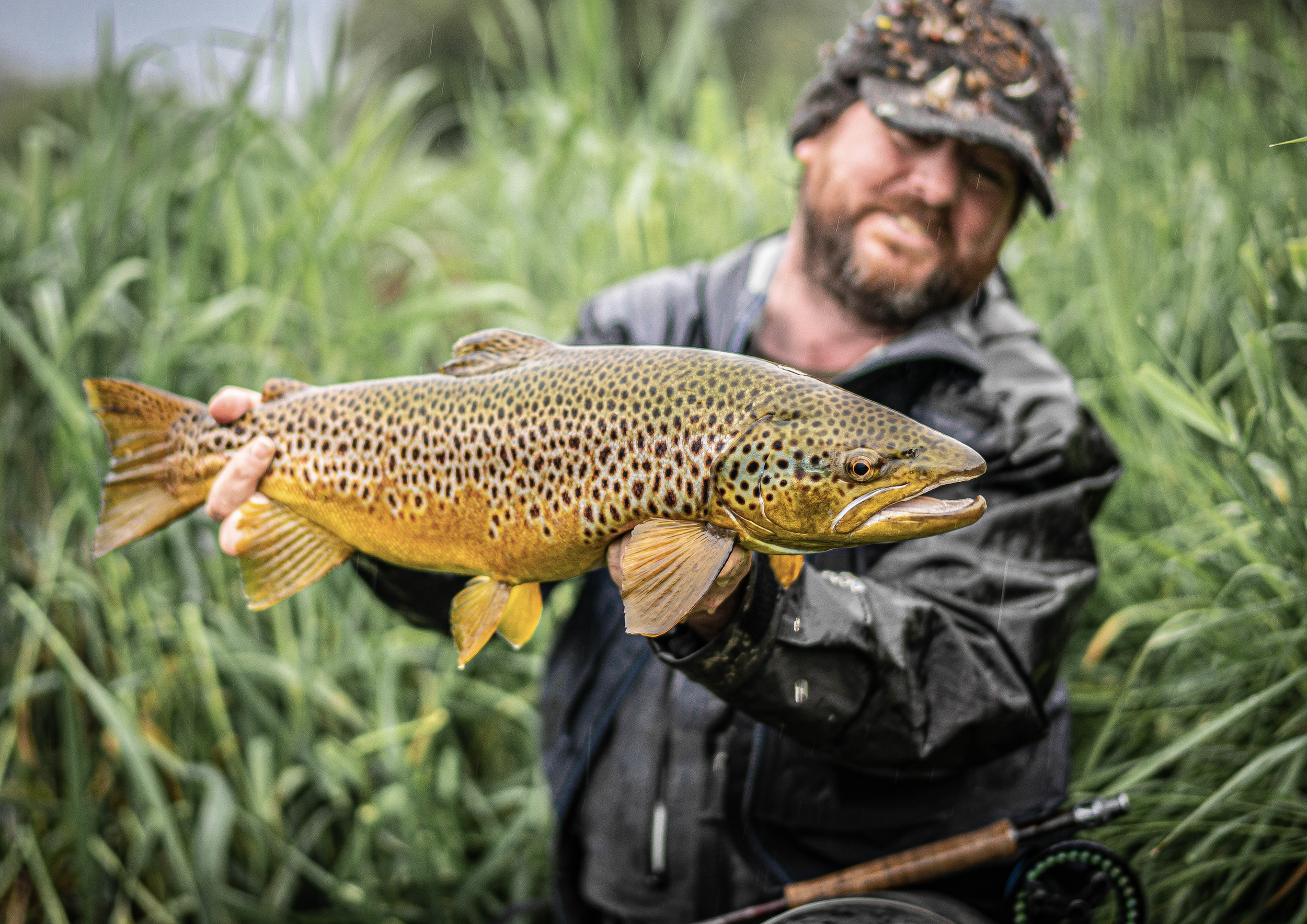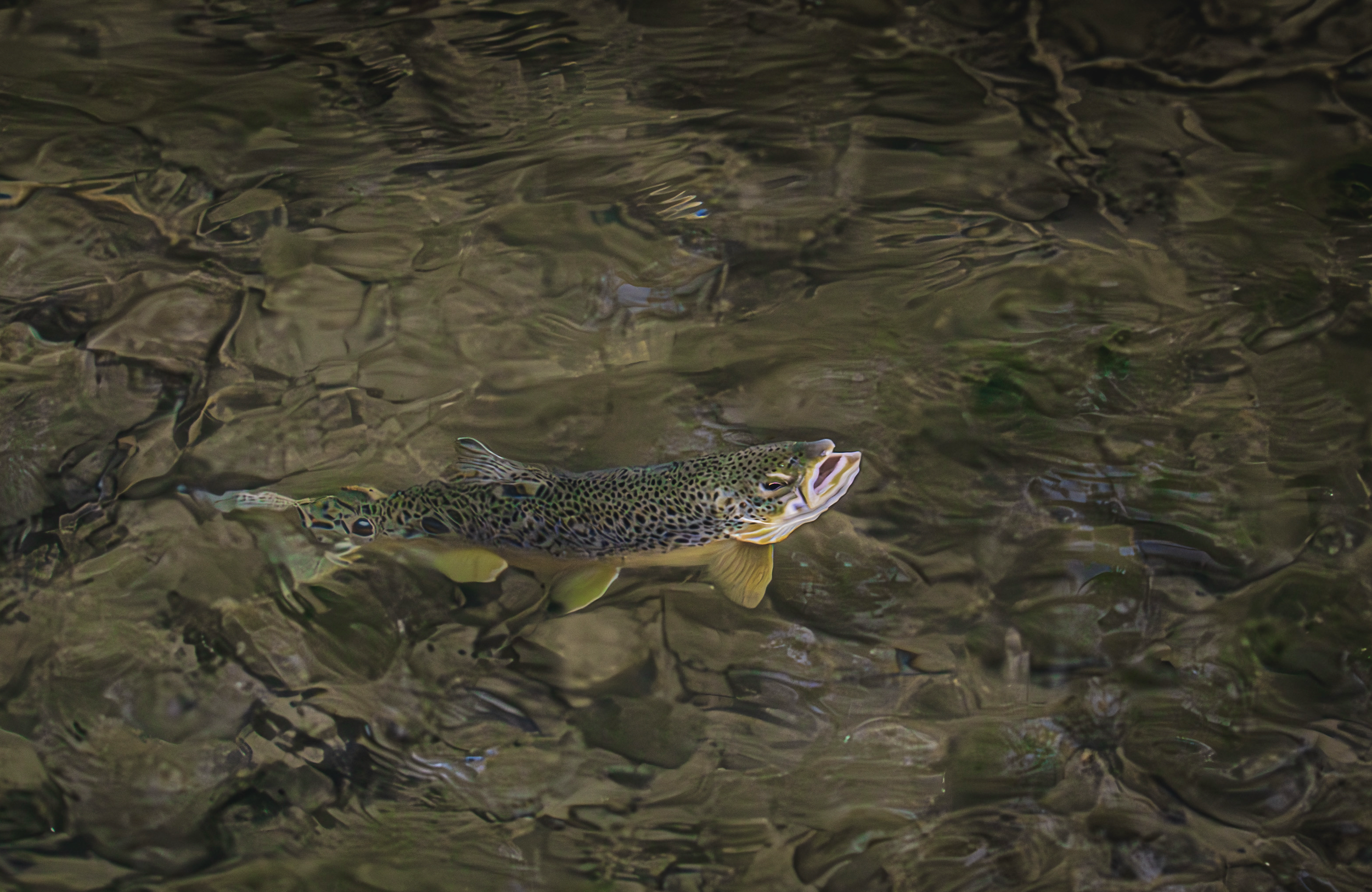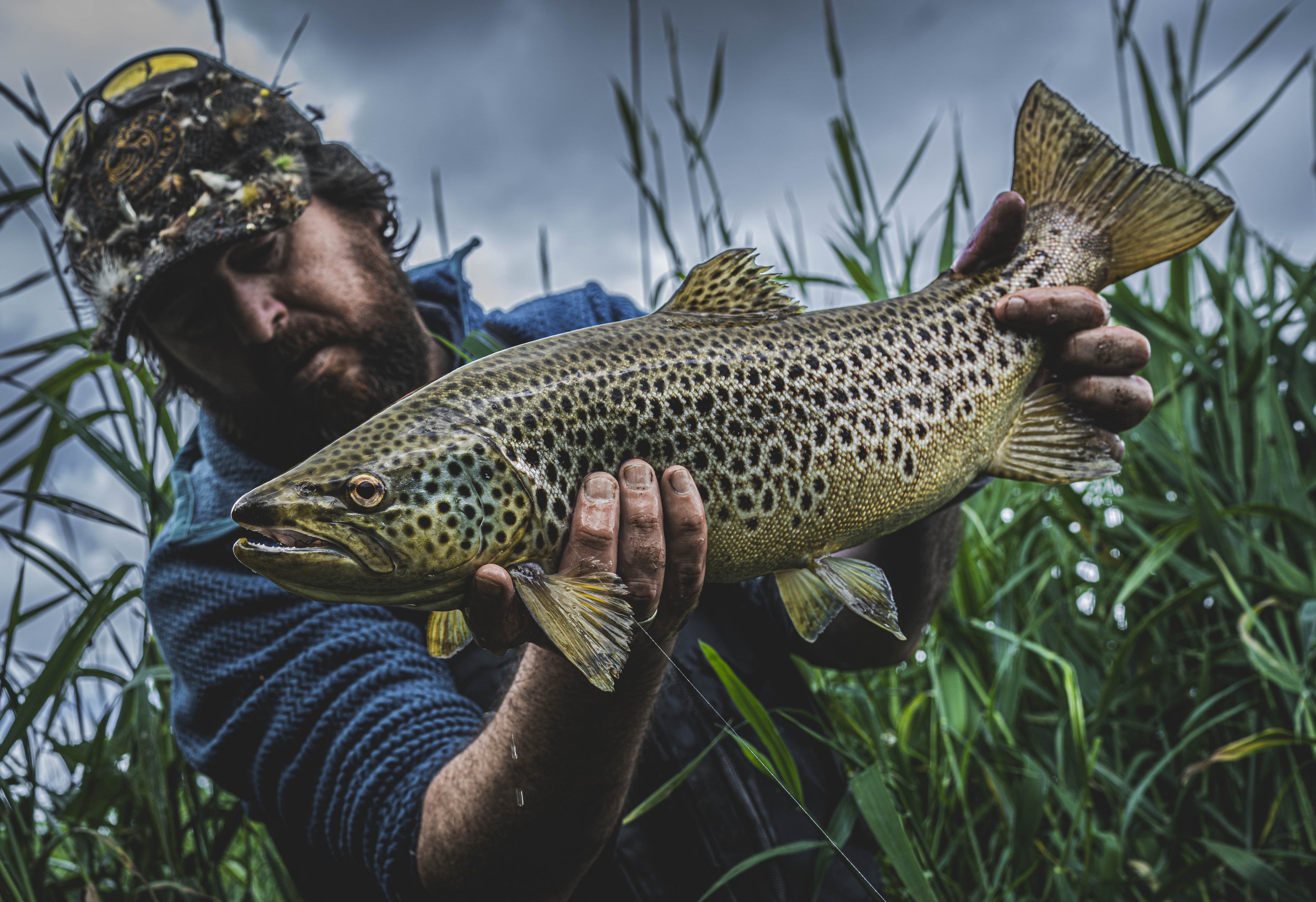
Keith McDonnell
1. Choice of equipment Rods, reels, fly lines, fly floatants, clothes, glasses, and other useful items.
I mostly use a fast action Sage Igniter 9ft 5 weight rod as it’s essential for me to be able to penetrate wind and cast distance and also be extremely accurate at all distances. Of course, we all would prefer within a couple of rod lengths of the fish but some of the rivers I fish aren’t wadable. I have read many people say that fast action rods are unsuitable for light tippets and this is not correct. Preventing broken tippet is up to the angler and not the rod. I use a softer rod if I need to roll cast in tighter spots. Ultimately, fly fishing is about confidence and the best dry fly rod is the one that inspires confidence and facilitates you best with presenting your fly with precision.
In my opinion, Scientific Anglers Amplitude smooth trout is by far the greatest fly line ever developed for stalking trout with small dry flies. The Amplitude line is hard wearing, true to grain weight, slick and supple, has a beautiful front taper and turns over long leaders..no they don’t sponsor me! I dislike the trend for making line fly lines heavier and shorter.
My favourite reel is an old Loop Danielsson Dry fly reel. It is bulletproof!
I carry a large diameter McLean sea trout net, the design is not perfect but it is essential for me to have a wide net with a long handle to be able to reach fish over tall weeds and bushes from high banks.
It is important for me to have waders that fit perfectly and are comfortable as I do a lot of walking between fish. While I try to keep wading to a minimum, it's necessary to have them to be able to get into the water to net and release fish where possible. I wear clothing that won’t stand out against the environment.
I like Tiemco dry magic and Loon Lochsa floatant as both are quite good for cdc. I also carry Loon dry shake as it's brilliant for rejuvenating a waterlogged or slimy fly. In the last year I’ve started using Piscari fly dry-x treatment that I apply when tying the flies and it is proving to be excellent and is non toxic.
A fly threader is an unfortunate necessity for me in low light with my eyesight deteriorating. The cheap plastic ones work very well with a little practice. Forceps are essential in terms of easily removing hooks for both fish welfare and big trout have big teeth and the bacteria resulting from being cut by a trout’s teeth mean getting “trout fingered” really hurts for a number of days afterwards!
Glasses are essential. I use a couple of different lenses but yellow are most useful for the conditions I like to fish in.
My hat is important too for helping to see into the water, spot fish, reduce glare and keep sun off my head and ears.
2. Leader material, build-up, length and knots
My standard leader setup is very simple. I use an Impact Fly Fishing Co 9ft supreme leader, perfection loop to loop on flyline and add 6 ft of fluorocarbon tippet using a triple surgeon's knot. I use as fine a leader as I can based on the size of fish I’m likely to encounter. My tippet is 4 to 7 lbs breaking strain normally. I do believe that fluorocarbon tippet has a number of advantages, and it is really important to check your knots before fishing and change tippet after a big fish. I would rarely ever go below 5x tippet. It’s surprising how much you can pull on 5x if your knots are good.
Photo credit: Ciaran O'Kelly
3. Approach and stealth.
This is one of the most important parts of the game. Many anglers approach fishing from the point of view of going out, getting into the water and fishing and that can be lots of fun. Everyone is different in how they take enjoyment from fly fishing. There are days where I never make a cast. I am looking for a fish first, then observing that fish and working out how to approach it. Getting into the best position undetected, delivering the fly to the right place at the right time so that the fish remains unaware that there is anything unusual. I’m often on my hands and knees. Two of the biggest dry fly fish I caught in 2024 were from lying on my belly and using just the leader to present the fly. It is possible to get very close to fish and remain undetected.
4. Reading the water.
To narrow down the search we need to be able to identify the type of water and structure that the fish prefer. My eyes are always scanning the water as far as possible for tell tale signs of a fish. Don’t turn your back on the water, you might miss something.
It’s important to be able to pre-empt how the current and structure will influence the line and fly land on the water and take appropriate measures to ensure the fly drifts as intended.
5. Casting ability which casts are essential.
Practice casting away from fishing. If you want to become a better angler, casting is an area to give serious attention. My casting mentor, Robert Gillespie once said that the “casting is the fishing”. He was absolutely correct. One of the keys to learning great fly casting control is the ‘Rod Pop’ exercise. Using this exercise to learn to efficiently control the tip of the fly rod is a game changer. The cast is no longer left to chance. I have Robert to thank for teaching me that too. I’ll write an article about that in the very near future. Ultimately loop control (being able to determine the shape, speed and trajectory of the line) results in Accuracy. In other sports great emphasis is put on practising accuracy. Why do so many neglect their casting?
It is really tough when you do everything right, locating a feeding fish, sneaking into place and watching a big trout feeding well only to mess it up with a poor cast.
Choosing the exact place you want the fly to land and watching that spot when making the delivery is a good tip for improving accuracy, it's amazing how much that helps.
When you are ready to make a presentation, take a breath, relax and think about casting calmly and gently before you make the final delivery. It’s so easy to get over excited or tense when you have a trout in your sights. If you rush it mostly results in hitting the rod too hard.. Poor presentation, catching the vegetation behind you, putting the fly in the wrong place… the list goes on.
Learn to control loop shape with a varying length of line in all planes ie off shoulder, side and back hand delivery.
Learn to double haul, there are many benefits; it is not just a distance technique. It means less false casting, faster delivery and when mastered additional loop control.
Learn to shoot line so that the fly line stays as far away from the destination during casting as much as possible.
It is very difficult to focus on all of these things while actually fishing.
The off season is a great time to work on casting, Good fly casting is a beautiful art and any investment in practice will pay off.
6. Entomology, what should we know?
In my opinion there was too much emphasis on this in the past but we appear to have moved on for the better. It’s fun to know some of the latin names but really you just need a basic knowledge of the insects that trout will feed on through the year. Don’t get hung up on fly colour and size. General purpose suggestive patterns are best. Some continue to perpetuate myths about particular shades of donkey urine and scaling down to microscopic flies etc. I think it can cause more harm than good for the beginning dry fly angler. Beware of advice from those who preach that these approaches are paramount, it tends to come from people who over inflate the mental capabilities of trout. Remember that fish are looking up at a silhouette. It’s more important to have absolute confidence in the fly you choose. The fish will accept a wide variety of flies. Keep it simple!. I love flies, anglers love flies, they are art, but the fish are much less discriminating. It's repeated regularly by anglers, I threw the box at him and he wouldn’t take anything. Trout often get too much credit. I dislike the old adage that big trout get big because they are clever. Trout often get big because not many people are fishing for them.
7. Rise forms Can they tell us something?
It may sound obvious but the name of the game is finding rise forms. It is a skill that improves over time to be able to scan water and identify the location of a feeding fish. It also pays greatly to tune into the sound of a rise and I believe this is a skill in itself to be listening and detecting the sound of a rise.
I don’t overly concern myself with rise forms in terms of what the fish are feeding on. They often take the same insect with very different rise forms. For example, a mayfly eat could be a slow head and tail, slashy, ploppy or just a gentle suck. It’s often not possible to determine the rise form due to distance, light conditions etc. I mostly determine what a fish is feeding on through observation of what’s on the water and what’s likely to hatch based on the time of year.
However, the frequency of rise forms gives us vital information about the behaviour of the fish, the likelihood of the fish taking your fly and how, when and where the fly should be delivered. Taking time to observe a rising fish helps to build a plan. It helps us understand how well the fish is feeding.
If a fish rises frequently then it helps give confidence that it is feeding well and it tips the odds of success in our favour. If a fish takes a number of flies in quick succession in the same location then we know the fish is most likely feeding confidently and more likely to move to a well presented fly. If the fish takes a natural fly or two and then stops for a time. We need to consider why, Is it cruising a beat or has it stopped rising? Fish can take one fly for many reasons, sometimes the movement of a natural fly triggers them and they can’t help themselves(there is lots to be unpacked in that alone), perhaps a fly trapped in the surface film in a certain way proves irresistible. They may have no further impetus to rise again.
We make decisions based on available information. If it’s a difficult day and it’s the only rise you see then it might pay to deliver your fly quickly. If you are out in great conditions and expect surface activity then the best choice may be to wait for the fish to begin rising more steadily before making your play. This is the fun and we win some and lose some but always gaining valuable information regardless of the outcome.
Another interesting aspect of rise forms is when the fish has come to your fly. We sometimes mistake a late rejection of our fly with a missed strike. For example if a fish is gently sipping naturals and as your fly passes over they appear to explode on it, that is sometimes a sign that the fish changed its mind at the very last second.
We don’t always get it right and it can be difficult to correctly time the strike. Many people strike far too quickly or have a one strike fits all. A 12 inch trout might take a fly in a microsecond, with larger trout it can be very important to pause before setting the hook. It’s something that’s difficult to master as we must decide so quickly based on what we observe. I’ve found it can actually be unnecessary to strike at all with the big guys and simply tighten up to them.
Fish will often cruise on a beat, even in moving water and the location or pattern of the rises gives us essential information about when is a good time to get into position and remain undetected, when or when not to cast. It’s a game of trying to make the best decision according to what we observe and rise forms help to inform a lot more than what the fish is eating.
8. Fly selection, Size, shape, materials, which flies are essential.
My favourites are a variant of Marjan Fratnik’s incredible F-Fly (I just include a spikey squirrel dubb on the body), Hans Van Klinkens Klinkhammer(I like a body of mixed seals fur, cdc post, and silver badger or grizzly hackle), Bob Wyatts Deerhair emerger and I am particular about the spent mayfly patterns I use such as the Paraglider and Slick drifter patterns. These flies work everywhere for me. I also like parachute flies because they sit low in the surface film. Scruffy flies are best, one of the most important attributes of a dry fly is its ability to make an impression or indents in the surface film. Trout will often take flies out of preference that appear less likely to escape. I firmly believe patterns like the Klink, DHE and the F-fly go a long way to achieving that appearance.
I also generally prefer a larger fly than the natural insect. People go to great lengths to have exact size and colour. Ballpark is generally enough, trout are greedy and refusal is more likely because of presentation than the pattern.
I had a recent experience with some large cruising trout along a sharp drop-off. The fish would hover underneath a fly sitting in open water on the outside of the drop off and reject it. If the fly was placed in very shallow water tight to the bank in inches of water they swam out of their way and took in confidently. Why? So there are two very likely reasons, because the fly was presented in shallow water, the fish were given a different view of the fly and couldn’t sit below to inspect it and there was only a very small amount of tippet lying on the water so the presentation looked very natural. In general, it is rare to experience such scrutiny from fish but these particular large fish see anglers almost everyday of the season.
9. Presentation and drifts.
Presentation is so important. Make sure to use an appropriate diameter tippet for the size of fly, size of fish and the given conditions. Use a tapered leader so that the fly will turn over as expected. Dial everything in so that you are certain that the leader and fly won’t land in a heap. It sounds obvious but we need reasonable confidence that the fly to go where we intend and not chance that it might. This also goes back to mastering casting so that we are not hoping that things will go right for us.
Take a moment to consider the best place to put the fly so the fish will see it. Being stealthy is the important part. Be confident and relaxed when making the presentation. Watch for the correct moment to present the fly if the fish is rising frequently.
In general it's best not to drop the fly on top of the fish. Trout can detect a fly from distances that are surprising. If you are fishing in clear low water for example it can pay to allow the fish to find the fly. By this I mean that the fly lands out of range of detection and drifts towards the fish they can be more confident about eating.
There are many times where the drop of the fly is a trigger for them to take also.
11. Fighting fish.
Play fish quickly and apply as much pressure as possible. There is a message that is repeated so often it’s not funny… to keep the rod tip up. That applies the least amount of pressure on the fish. Know the limitations of your setup so that you can use appropriate force at the appropriate time. Try to keep the fish on a short line where possible. Allow them to run but apply pressure to slow the run. Change the angle of the rod according to the fish’s location. If you want to keep them away from a snag then pull from that direction so they will be more inclined to oppose the direction of pull. Don’t muck around with landing nets that are too small. They are more convenient to carry, however a net that will extend and easily fit a large trout is worth its weight in gold. We all like a grip n’ grin for a good fish and a decent net to hold the fish while we prepare for a picture is kinder to the fish.
Photo Ciaran O'Kelly
